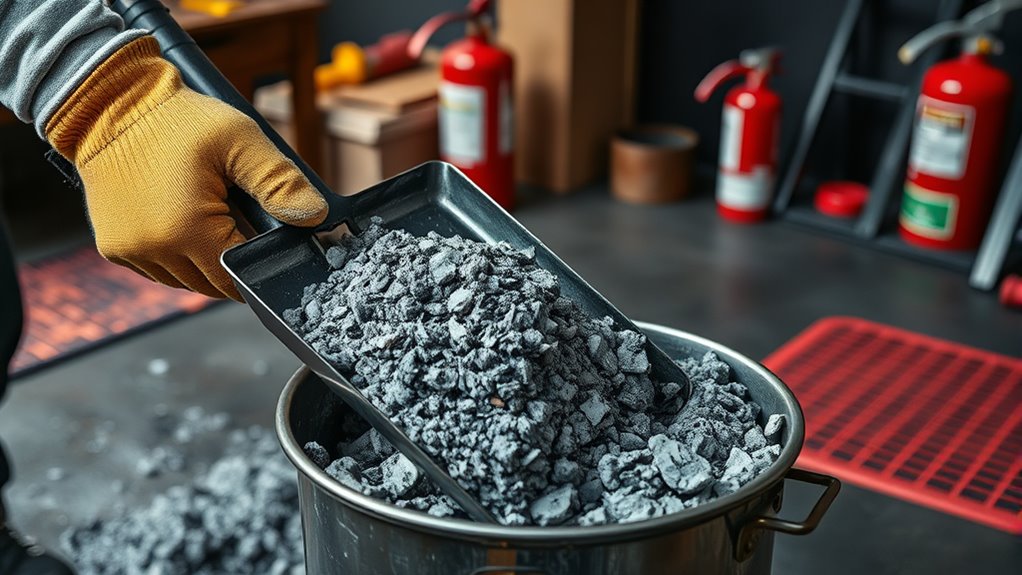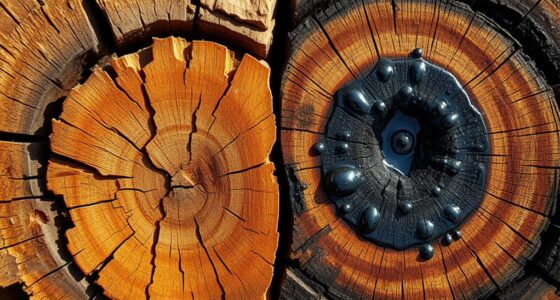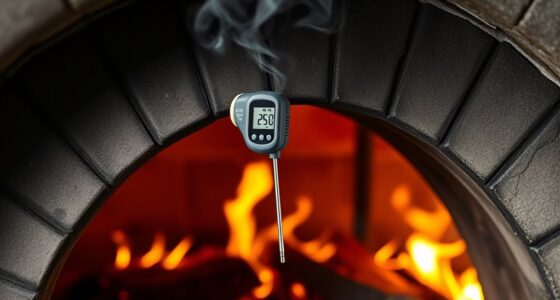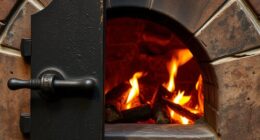To clear ashes safely, guarantee the fire is completely out and cooled before handling. Wear fireproof gloves, use a sturdy metal container, and gently scoop out the ashes to prevent scattering hot particles. Always wait several days for the ashes to cool fully before disposal and avoid plastic or flammable containers. Store the cooled ashes in a sealed metal container away from combustible materials. For detailed tips on preventing burns and damage, keep exploring these safety steps.
Key Takeaways
- Ensure ashes are completely cooled before handling using a metal container with a tight lid.
- Wear fireproof gloves and use a sturdy, heat-resistant scoop to carefully collect ashes.
- Avoid cleaning or disposing of ashes while the fire is still burning or hot.
- Follow local disposal regulations, never use plastic containers, and store ashes away from combustible materials.
- Thoroughly clean the ash chamber and confirm all ashes are fully cooled to prevent re-ignition or damage.

When it’s time to clear ashes from your fireplace or stove, safety should always come first. Handling ashes might seem straightforward, but they can be unexpectedly hot or contain smoldering embers that reignite if not managed carefully. To protect yourself, always wear fireproof gloves. These gloves provide a vital barrier against heat and prevent burns, especially since ashes can retain heat for hours after the fire has gone out. Using the right gloves makes ash disposal safer, giving you confidence that you’re shielded from potential burns or sparks that could cause injury.
Before you start removing ashes, confirm the fire is completely out and cooled down. Never attempt to clean ashes while the fire is still burning or hot. Once cooled, gather your fireproof gloves and a sturdy, heat-resistant container—preferably metal—for ash disposal. Avoid using plastic or flimsy containers, as they can melt or ignite if any residual heat remains. Carefully scoop the ashes into the container, taking your time to avoid scattering hot particles into the air. Be gentle and deliberate, making sure not to disturb any remaining embers that could reignite or create a fire hazard.
When disposing of ashes, always follow local regulations and guidelines. Many communities have specific rules on ash disposal, often requiring you to wait several days after burning before removing ashes to confirm they’re fully cooled. Never dispose of ashes in regular trash bins or leave them outside in paper bags or cardboard boxes, as these materials can catch fire if still warm. Instead, place the cooled ashes in a metal container with a tight-fitting lid. Store this container away from combustible materials, such as wood decks, paper, or fabric, until you’re ready to take it to an approved disposal site.
In addition to using fireproof gloves, keep a metal scoop or ash shovel handy. This helps you handle ashes more precisely and minimizes the risk of accidental spillage or contact with hot particles. After disposal, clean out the ash chamber of your stove or fireplace thoroughly, removing any residual dust or small embers that might pose a risk later. Always wash your hands afterward, especially if you didn’t wear gloves, and double-check that all ashes are fully cooled before leaving the area. Proper disposal practices also help prevent potential hazards and contribute to overall fire safety.
Frequently Asked Questions
Can I Reuse Leftover Ashes for Gardening or Compost?
Yes, you can reuse leftover ashes for gardening or composting ashes. Ash reuse works best with wood ashes, which add potassium and minerals to your soil. Just guarantee the ashes are completely cool before handling, and avoid using ashes from treated or painted wood. Mix composting ashes sparingly into your soil, as too much can alter pH levels. Properly used, ashes can be a beneficial addition to your garden.
What Are the Signs of a Chimney Fire Caused by Improper Cleaning?
If you notice chimney smoke or an unusual odor coming from your chimney, you might have a chimney fire. Signs include loud cracking or popping sounds, intense heat around the chimney, and visible flames or glowing embers. You should act quickly, shut off the damper, and call emergency services. Avoid opening the fireplace or attempting to extinguish the fire yourself, as this can worsen the situation.
How Often Should I Have My Fireplace or Stove Professionally Inspected?
You should schedule professional safety inspections annually to make certain your fireplace or stove stays safe. Regular chimney maintenance helps detect hidden issues before they become dangerous. Skipping inspections can lead to costly damage or dangerous fires. Don’t wait for warning signs—trust experts to evaluate your chimney’s condition, clean it thoroughly, and keep your home secure. Staying proactive with inspections guarantees peace of mind and safe, cozy fires all season long.
Are There Eco-Friendly Methods for Disposing of Ashes Safely?
You can use eco disposal methods like composting or repurposing ashes for gardening. Ash reuse is an eco-friendly way to enrich soil, especially for alkaline-loving plants. Make sure ashes are completely cool before handling, and avoid disposing of them in plastic or flammable materials. You might also consider spreading a thin layer of ash in your garden beds to improve soil health, reducing waste while benefiting your plants.
What Protective Gear Is Recommended When Cleaning Ashes in Tight Spaces?
Think of yourself as a firefighter entering a smoky room—you need protection. Wear fire-resistant gloves to guard against residual heat and sharp debris, and don a dust mask to prevent inhaling fine ash particles. These safety gear pieces act as your armor, ensuring you stay safe while maneuvering through tight spaces. Always prioritize your protection, because even in small areas, ash can pose unexpected hazards.
Conclusion
By following these safety tips, you’ll keep your fires burning bright without risking burns or damage. Think of your fireplace as a delicate garden—you must tend to it with care and respect. Always clear ashes carefully and clean thoughtfully, turning potential hazards into nothing more than distant memories. With patience and caution, you’ll guarantee your home remains warm, safe, and inviting, like a cozy fire that gently warms both your hearth and your heart.









